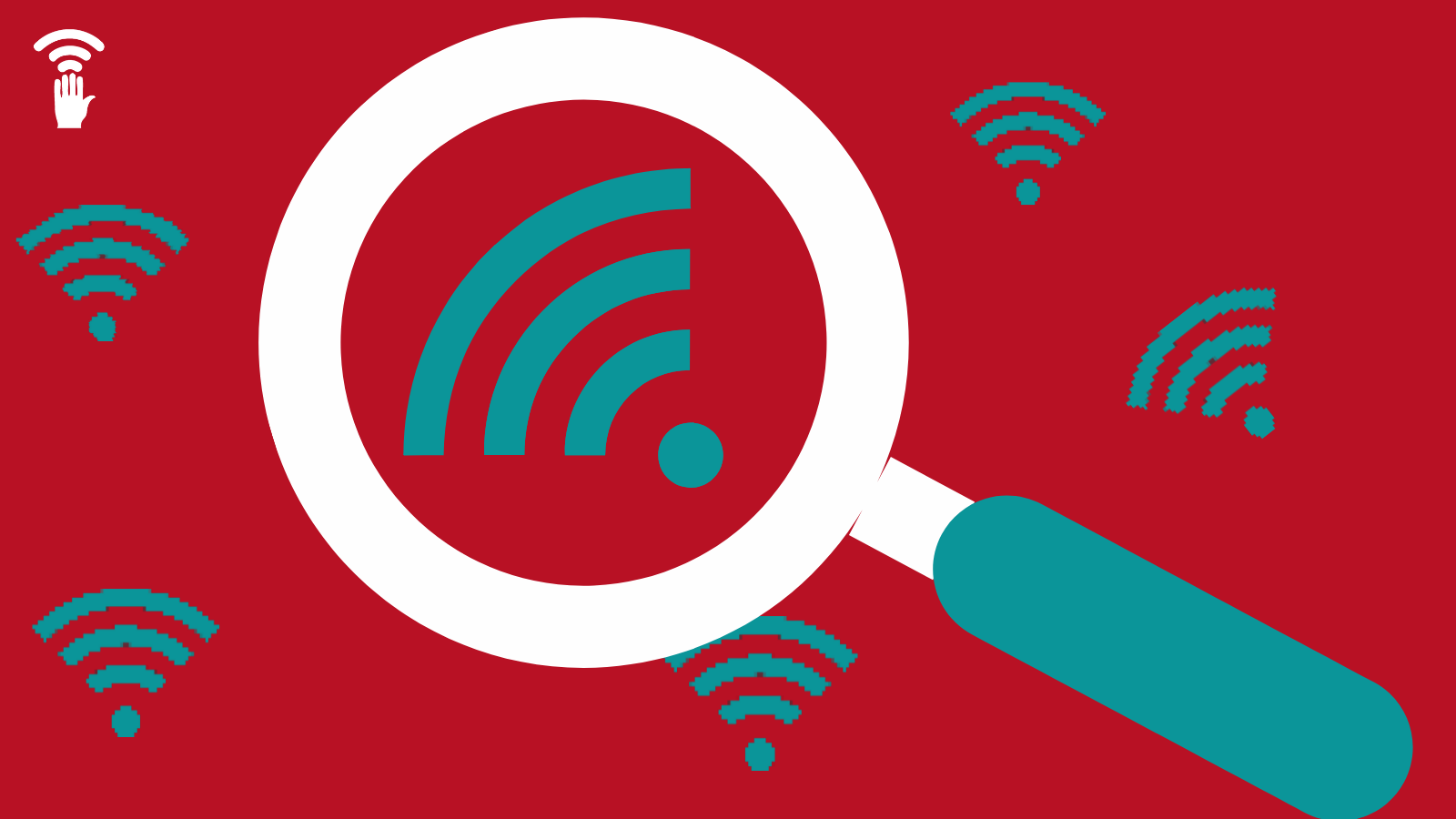
On May 9, the White House announced it secured commitments from 20 internet service providers (ISPs) to offer high-speed internet (at least 100 Mbps download speed) plans for no more than $30 per month. (You can read more about the White House announcement here.)
These new $30, high-speed plans are an enormous step in the right direction to making the internet more affordable for all consumers. Critically, consumers who are participating in the Affordable Connectivity Program (ACP) can apply their $30 to these plans and receive internet at no cost—since many of these plans come with free installation and no extra fees.
A few of these plans are also available to consumers who are not participating in ACP but would like to sign up for affordable internet.
NDIA commends both the White House for securing these commitments and the 20 ISPs who are now offering $30, high-speed plans, which will make a big difference for many households. We encourage other ISPs to do the same. You can access a detailed catalog of these $30, high-speed plans and other low-cost plans on our freshly updated Free & Low-Cost Plans page.
While we applaud these plans, for the plans to achieve the intended outcome of making the internet more affordable, robust information regarding these plans must be easily accessible to consumers and customer service representatives must be well-informed about the new plans and the Affordable Connectivity Program.
To better understand these plans, how consumers can access them, and how NDIA’s community can support enrollment in them, we collected as much information on the plans that we could find while simultaneously documenting our experience from a consumer’s point of view. Based on our experience, we are concerned that at the moment, too many barriers for seamless enrollment in these new plans exist.
The remainder of this post details our experience gathering this information and detailed recommendations for addressing these barriers. But to sum them up, we recommend any ISP currently offering or considering offering one of these $30, high-speed plans to:
- Train and educate their employees to be able to assist customers asking about the new low-cost plans and how to sign up for ACP
- Make all information about the plans easily available and transparent
- Expand eligibility for the $30, high-speed plans so more consumers can access these affordable plans.
Where We Looked and What We Found
We looked for the following information for each of the $30, high-speed plans:
- the existence of the low-cost plan
- the speeds (download and upload) of the plan
- any other fees, terms, and conditions associated with the plan
- who is eligible for the plan – whether it’s limited to ACP-approved consumers or available to other customers as well
We first looked for this information on each ISP’s website.
Unfortunately, the availability and transparency of information about these $30, high-speed plans was often lacking on the ISPs’ websites.
For instance, Starry’s ACP page indicates that its plans up to $30 per month will give ACP consumers free internet service. However, the page and the rest of Starry’s website provides no information about any of Starry’s $30 or under plans to begin with, let alone their speeds, data caps, and other costs.

We reached out directly to a senior Starry staff member and received more details about Starry’s $30 and $15, high-speed plans, which can be found on our updated Free & Low-Cost Plans page.
Hawaiian Telcom’s ACP page advertises its FREE Fioptics 100 Mbps Fiber Internet plan for ACP customers.
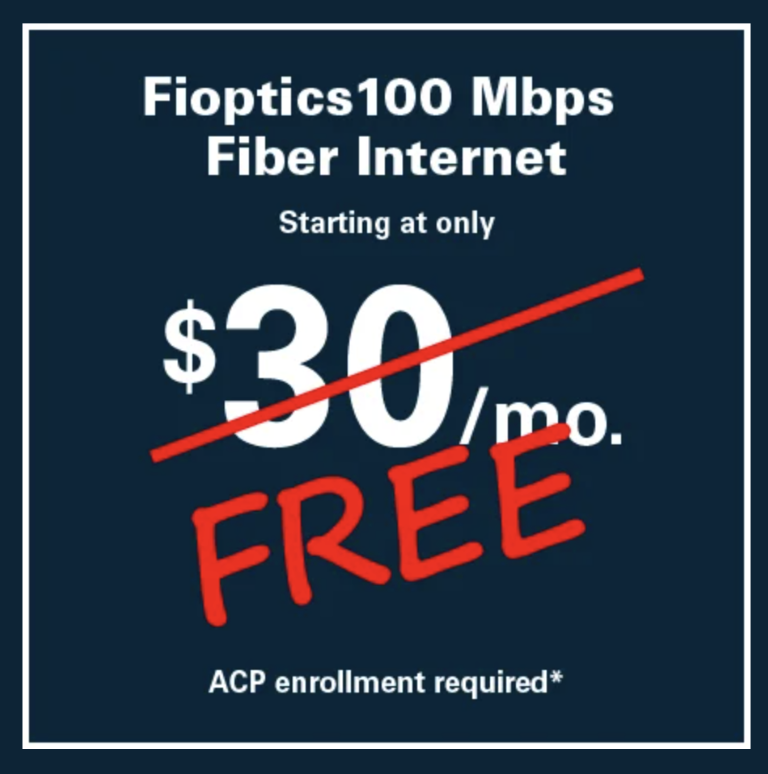
However, the page (and the rest of Hawaiian Telcom’s website) does not include any details about the Fioptics 100 Mbps Fiber Internet plan beyond the implication that it provides 100 Mbps download speeds. After speaking with two different customer service representatives, we were able to learn more, which we have documented on our updated Free & Low-Cost Plans page.
Spectrum’s ACP page mentions its $29.99 plan, which includes a modem, in-home Wi-Fi, and self-installation at no additional charge. However, at the bottom of the page is fine print that reads: “Spectrum Internet 100 promotion price (including WiFi) is $29.99/mo for 2 years; standard rates apply after promotional period.”

A Spectrum customer service representative confirmed that after two years, the price of the $29.99 plan will most likely increase by $10, which could come as an unpleasant surprise to ACP customers on the plan. While ACP rules do not prohibit ISPs from raising the cost of their service plans, unexpected price increases buried in fine print could cause confusion for consumers and erode trust in ACP.
While we are glad that ISPs are offering $30, high-speed plans, consumers should be able to readily see on ISPs’ websites the download and upload speeds, costs, and terms and conditions associated with these plans. Too often, the ISPs’ websites fail to provide enough (or transparent enough) information about their “$30, high-speed” plans. As a result, we resorted to online chatting with or calling each ISP directly to fully answer our questions.
Obtaining information from customer service representatives was sometimes difficult …
Several customer service representatives were under-informed about their ISP’s available low-cost plans, the Affordable Connectivity Program writ large, and even broadband basics.
The White House press release about the new low-cost plans states: “Verizon lowered the price for its Fios service from $39.99/month to $30/month for a plan that delivers download and upload speeds of at least 200 Megabits per second.”
To find out more about this plan, we contacted Verizon agents via chat box. One Verizon agent insisted that Verizon was not offering a $30 plan.
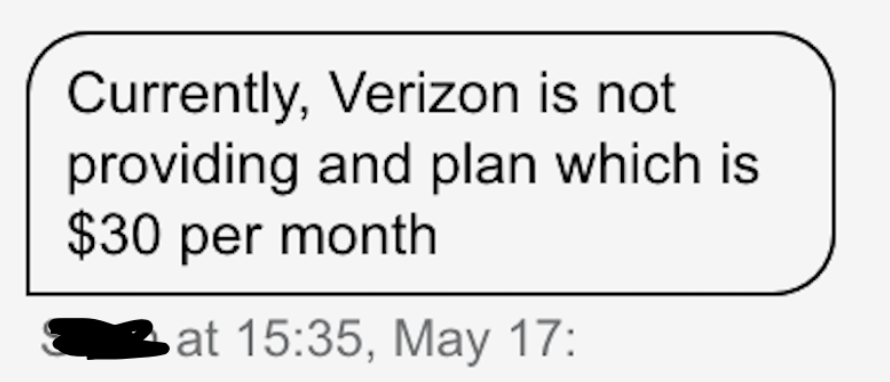
We asked the agent to ask their supervisor about the new $30, high-speed ACP plan that Verizon had committed to offering. The agent replied:
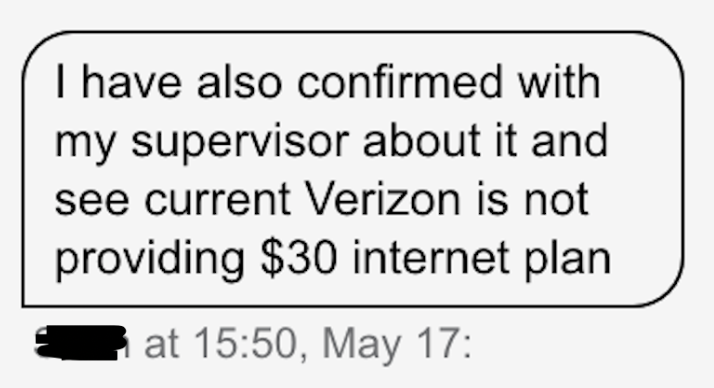
We then chatted with another Verizon agent, who would not answer our questions about Verizon’s $30, high-speed plan unless we provided a residential address.
Next, we called Verizon’s customer support. When we asked a Verizon representative why there was no $30 internet plan on its Fios Forward page, the representative said they were not aware that the Fios Forward program existed and that we were “teaching her” things.
The Verizon representative then transferred us to someone at Verizon’s “ACP department.” We asked the same question, and they replied, “ACP provides a $30 discount to your internet service.” Despite trying to lay more foundation and rephrasing our questions, it was clear that the extent of this representative’s knowledge about ACP was that it “provides a $30 discount to your internet service.”
Finally, NDIA emailed a senior contact at Verizon, who was very helpful and clarified that Verizon’s $30, high-speed plan mentioned in the White House press release is the same as Verizon’s Fios Forward 300 plan (below). The price of this plan is still listed as “$39.99 or free with Fios Forward and the ACP benefit,” which contradicts the White House Press release that says “Verizon lowered the price for its Fios service from $39.99/month to $30/month.”
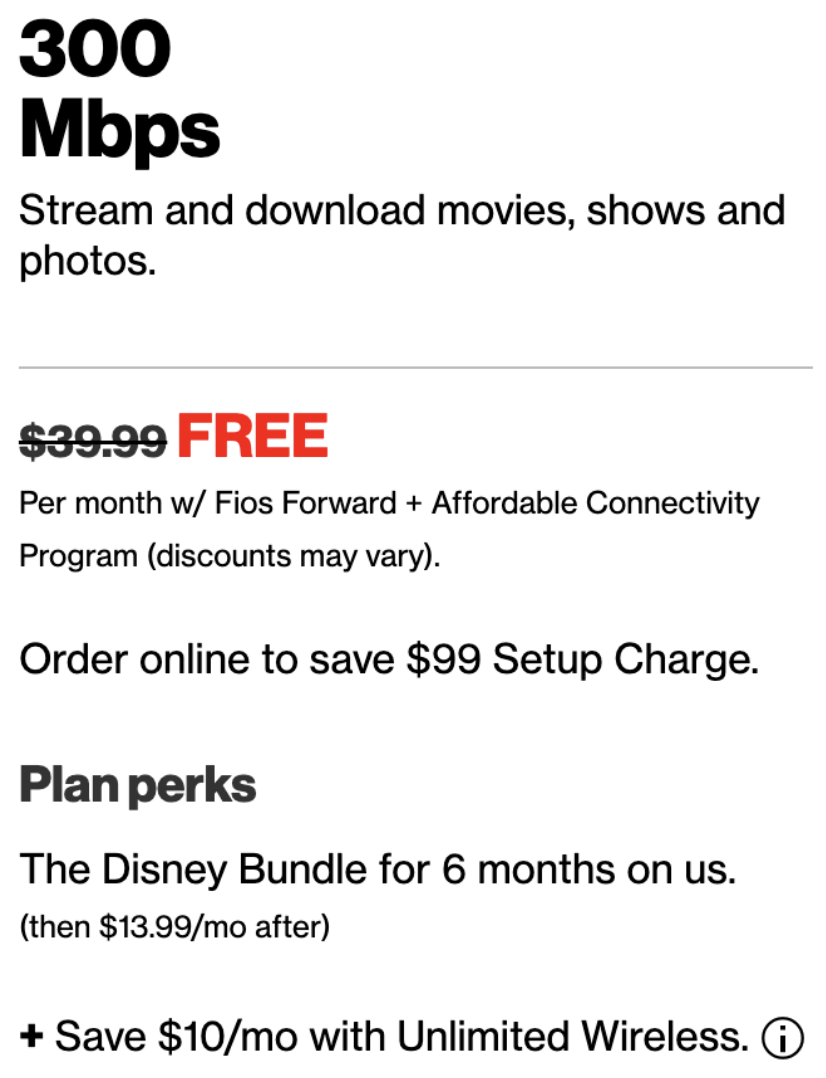
In any case, our understanding is that Verizon will cover the costs of the plan that the ACP benefit does not, and ACP consumers can receive free service through Verizon’s Fios Forward 300 plan. NDIA would encourage more clarity on Verizon’s website to this effect, since consumers may find it difficult to identify Verizon’s $30, high-speed plan if it is not listed as such on the Fios Forward page.
When asking AT&T about its $30, high-speed plan, we were told by three different customer service representatives that the cheapest plan offered by AT&T was $60. We have since clarified with an AT&T external affairs representative that AT&T does offer a $30 Access from AT&T plan with no equipment charge, no installation fee, and no data caps.
We also had a difficult experience with an Optimum representative. When we asked Optimum about the upload speeds of its $30, high-speed plan, the representative, who did not seem to understand our question, was unable to provide an answer. We tried rephrasing our question, but then the customer service representative hung up on us.
Much of the information we received from customer service representatives contradicted the information advertised on ISP websites.
A Spectrum customer service representative insisted that its $30, high-speed plan (Spectrum 100) comes with, at minimum, a $20 self-installation charge. However, Spectrum’s ACP page shown below states that Spectrum 100 includes self-installation “at no additional charge.”

Xtream (powered by Mediacom) offers a Connect2Compete Plus plan, which provides up to 100 Mbps download speeds, a modem, in-home Wi-Fi, unlimited data, and self-installation at “no cost” to ACP-approved consumers.
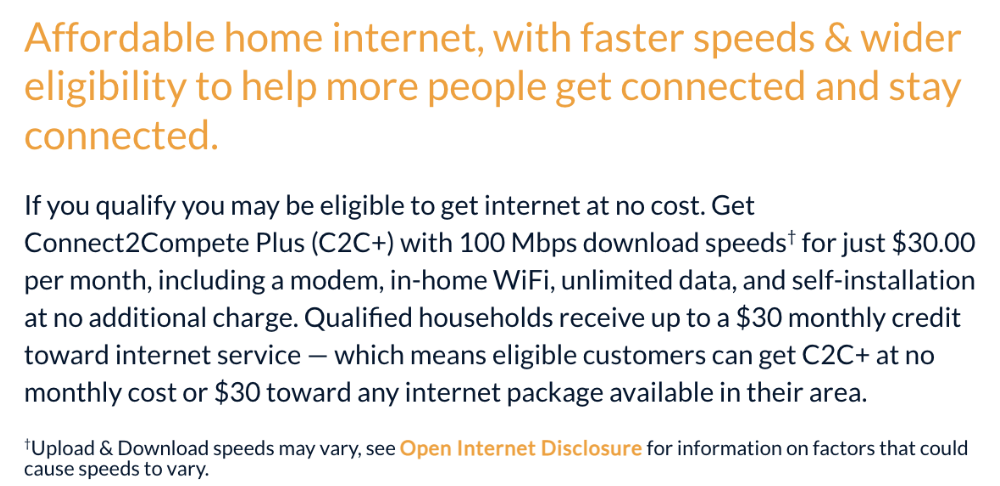
When we asked an Xtream customer service representative about the speeds of its Connect2Compete Plus plan, we were told the speeds are 50 Mbps download and 5 Mbps upload. We reiterated that the website clearly says up to “100 Mbps” download speeds, but the Xtream representative continued to insist that download speeds are only “50 Mbps.”
A different Xtream representative contradicted the previous representative, clarifying that the download speed for the Connect2Compete Plus plan is in fact 100 Mbps.
This representative also told us that the Connect2Compete Plus comes with a 250 GB data limit. We suspect that this representative was misinformed, since a senior Mediacom staff member (as well as the website itself) confirmed that Connect2Compete Plus comes with unlimited data.
Wow! Internet, Cable and TV offers an ACP Internet 100 plan “FREE” to ACP households. The website is clear: “This special $0 price includes free self-installation and no modem rental fees with unlimited data. The price remains $0 as long as customers continue as qualified participants in ACP.”

However, the first time we called Wow!, we were told that only two areas in which Wow! provides service offer free modems. All other service areas have a $14 monthly modem rental fee. In addition, we were told that after 12 months, the promotional price of Internet 100 ($19.99) would increase to $39.99 (which would leave ACP customers with at least a $10 bill). We also learned that existing Wow! customers who want to switch to Internet 100 may or may not receive the $19.99 new customer rate.
We suspect that this customer representative was conflating Wow!’s ACP Internet 100 plan, which should not have extra fees or price increases, with Wow!’s ‘Standard’ Internet 100 plan, which may have extra fees and price changes (see below).

We called Wow! again one week later to clarify. This time, the customer representative explained that the Internet 100 plan is free for ACP customers. There are no extra fees that ACP customers must pay out of pocket and there are no price increases.
Are these $30, high-speed plans really free?
Vexus Fiber, which serves areas in Texas, Louisiana, and Mississippi, advertises its Vexus 150 Mbps High-Speed Internet plan as “FREE INTERNET” for ACP households. Note the asterisk next to “Your total monthly cost.”
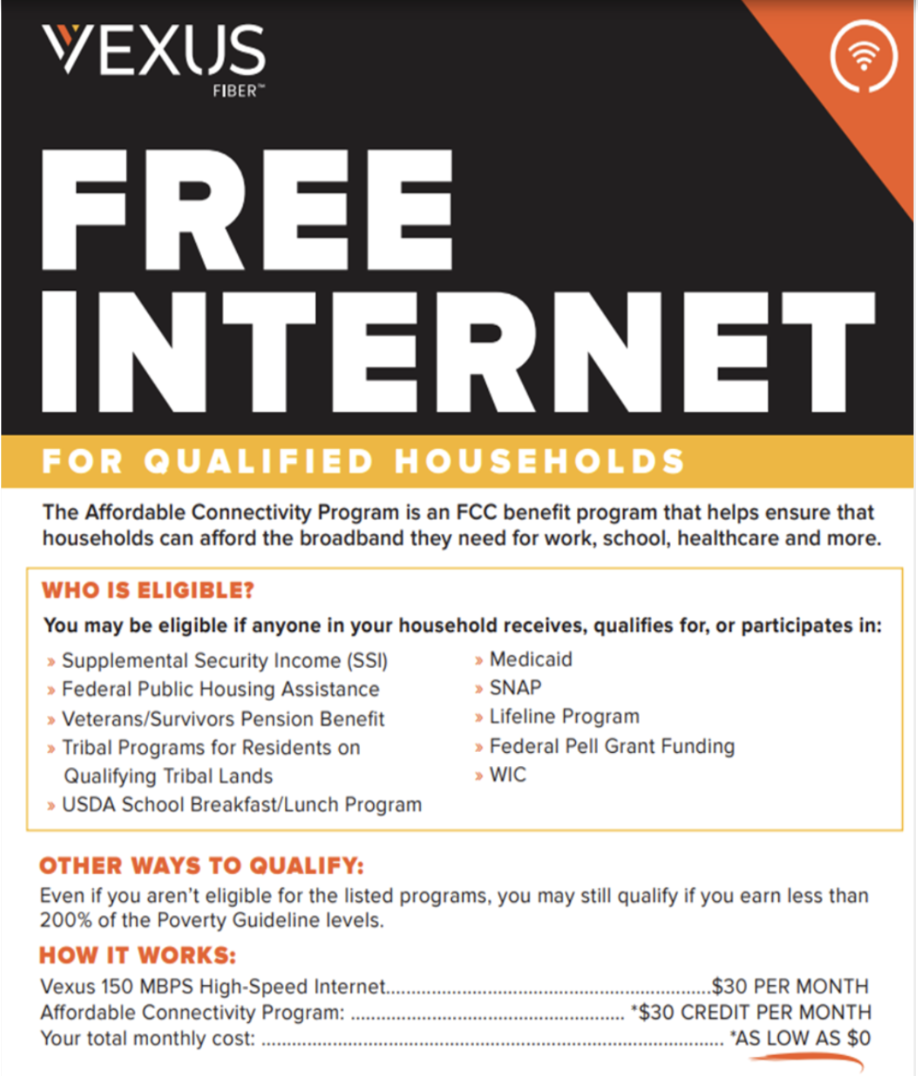
We contacted Vexus Fiber and learned that the $30 ACP benefit will not cover the taxes, the $10 monthly access fee, and the $7 monthly router rental fee associated with the Vexus 150 Mbps High-Speed plan.
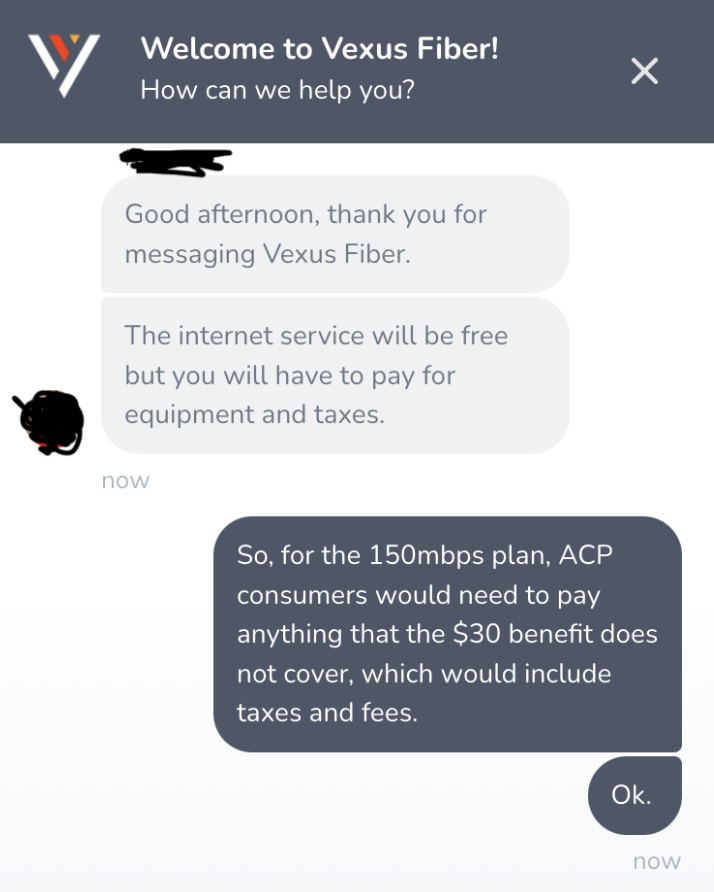
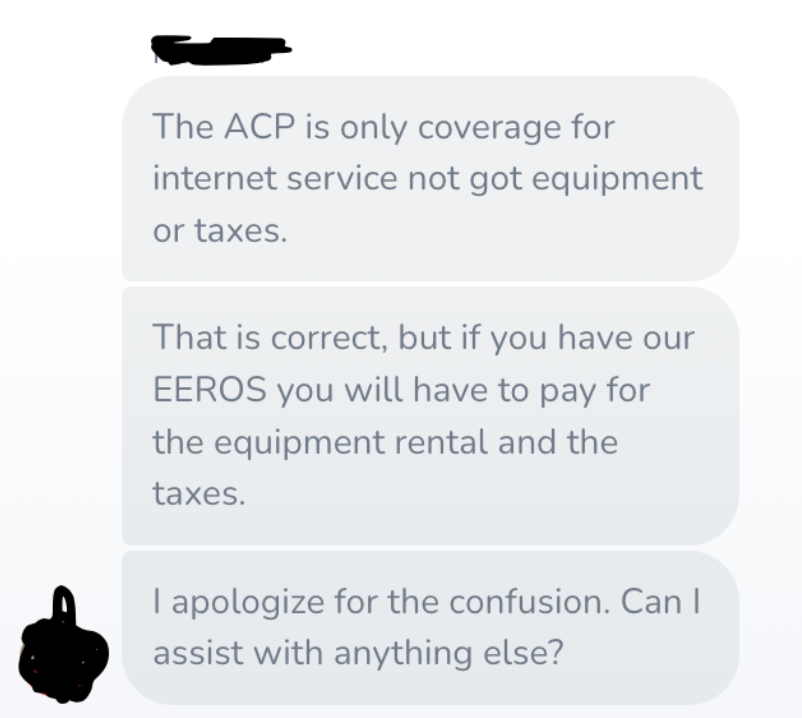
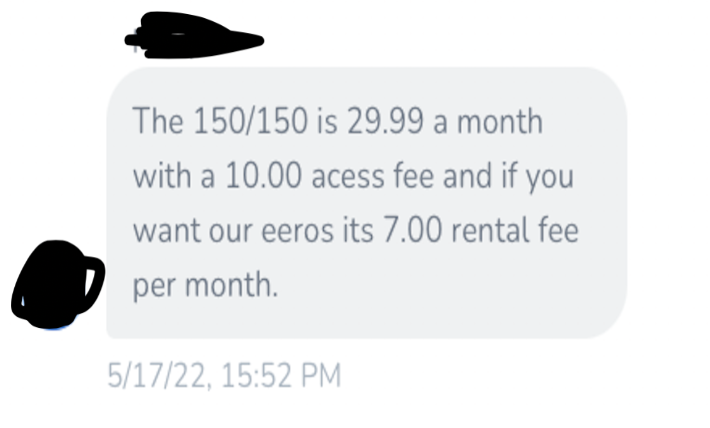
Note: It’s possible that Vexus waives taxes and fees for ACP customers, but nothing on their website or in our conversations with their service representatives indicated that.
Spectrum’s Internet 100 plan also may not be free—at least not forever. See the fine print below about Spectrum Internet 100’s limited time promotion price:

A Spectrum customer service representative confirmed that after two years, the price of the $29.99 plan will most likely increase by $10. If this is true, ACP customers on Spectrum Internet 100 will need to pay out-of-pocket costs when the promotional period ends.
We are incredibly excited about the new $30, high-speed plans. The NDIA community should be too. They are enormously valuable to consumers and can play a positive role in advancing broadband affordability and bridging the digital divide.
However, the search for detailed and accurate information about the new $30, high-speed plans was challenging for us. To fully take advantage of these affordable offers, consumers should be able to easily access detailed and accurate information about these plans.
Here are some suggestions to improve the consumer experience and ensure as many consumers as possible can access these plans:
1. Education and Training
ISPs need to make a stronger effort to train and educate their employees so that they can better assist ACP customers. Customer service representatives should understand how ACP works, which low-cost plans are offered, and the true out-of-pocket costs associated with those plans (particularly for ACP customers). Representatives should not be disseminating information that is inconsistent with information advertised on the ISP’s websites or the ACP program itself.
Often, ISPs have special plans and rules for ACP-approved customers, but customer service representatives are often unaware of them or when to apply them. Representatives should know which particular plans and rules apply to ACP-approved customers.
When a customer is applying their ACP benefit to an internet service plan, the ACP protections in the program rules legally override any rules that an ISP may have, when in conflict. For example, ACP rules prohibit ISPs from declining to enroll a customer in an ACP-discounted plan due to past debt. As such, while an ISP is allowed to have a past debt requirement on its low-cost plans generally, that ISP cannot enforce such a requirement when a customer is trying to apply their ACP benefit to the ISP’s low-cost plan.
Note: ACP rules trump ISP rules, but only in the context of a customer that is trying to apply their ACP benefit. If a customer is already using their ACP benefit on, say, a mobile plan, and wants to sign up for a ISP’s low-cost wireline plan, that customer is subject to all of the ISP’s requirements associated with that low-cost wireline plan.
2. Make Information Available and Transparent
ISPs should clearly display all of the terms and conditions associated with their low-cost offers on their website. Customers should not have to navigate their way through an automated phone system in order to find out the upload speeds for these plans—for instance.
In addition, ISPs should not advertise their $30, high-speed plans as “Free” if they are not truly free. ISPs should be transparent about any taxes, fees, and promotional periods that may result in some out-of-pocket costs to ACP customers.
3. Expand Eligibility for $30, High-Speed Plans
Vexus Fiber does not limit its $30, high-speed plan only to ACP customers or to those who meet certain low-income eligibility requirements. We encourage other ISPs to follow Vexus Fiber’s lead and make their $30, high-speed plans available to all of their customers.
With more informed custom service representatives, clear and transparent ISP websites, and expanded eligibility, the new $30, high-speed plans can achieve their true potential.
Note: We encourage ISPs, our affiliates, and others to share additional information that may correct, clarify, or add to our understanding of the new $30, high-speed plans. Please send information and inquiries to [email protected]
